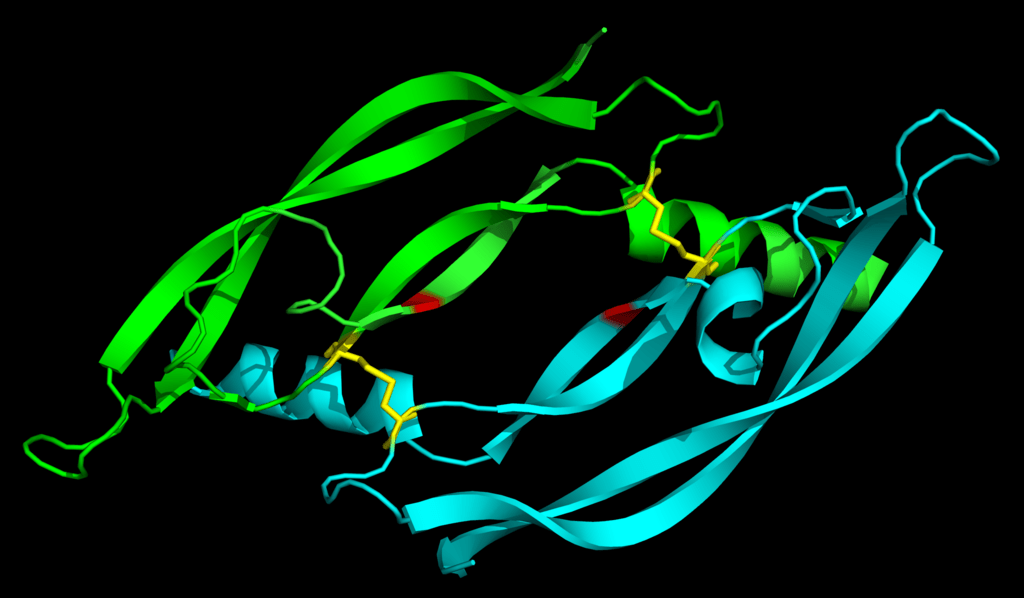Difference Between VEGF and EGFR
The key difference between VEGF and EGFR is that VEGF is a signalling protein that promotes the growth of new blood vessels and restores blood supply to cells and tissues, while EGFR is a transmembrane protein that stimulates DNA synthesis and cell proliferation.
VEGF and EGFR are proteins involved in different signalling reactions in the body. They perform different functions that are extremely important for haemostasis. Vascular endothelial growth factor is a signalling protein. One of the main functions of this protein is to form new blood vessels. It also stimulates the growth of new blood vessels after injury. On the other hand, epidermal growth factor receptor is a transmembrane protein that acts as a receptor for members of the epidermal growth factor family (EGF family). Its main function is the stimulation of cell proliferation.
CONTENTS
1. Overview and Key Difference
2. What is VEGF
3. What is EGFR
4. Similarities Between VEGF and EGFR
5. Side by Side Comparison – VEGF vs EGFR in Tabular Form
6. Summary
What is VEGF?
Vascular endothelial growth factor, originally termed as vascular permeability factor (VPF), is a signal protein. It is produced by fibroblasts cells. It stimulates the formation of new blood vessels. They are very important signalling proteins. They are involved in both vasculogenesis and angiogenesis. It is a part of the system that supplies oxygen to the parts of the body when blood circulation is inadequate (hypoxia). The serum concentration of VEGF is high in conditions such as bronchial asthma and diabetes mellitus. The normal function of VEGF is to create new blood vessels during embryonic development. It is also involved in new blood vessels formation after injury, muscles’ activity following exercise, and new blood vessels formation (collateral circulation) to bypass blocked vessels.

Figure 01: VEGF
It can also contribute to diseases. Cancers that can express VEGF are able to grow and metastasize. The overexpression of VEGF can also cause vascular disease in the retina of the eye and other parts of the body. Drugs such as aflibercept, bevacizumab, ranibizumab, and pegaptanib can inhibit the overexpression of VEGF.
What is EGFR?
EGFR receptor (epidermal growth factor receptor) is a member of the ErbB receptor family. It is a transmembrane protein mainly involved in cell proliferation. Stanley Cohen discovered the epidermal growth factor and its receptor, and he won the Nobel prize for it in 1986. Epidermal growth factor receptor (EGFR) is activated by binding of its specific ligands, including the epidermal growth factor and transforming growth factor α (TGFα). Upon activation, EGFR undergoes an inactive monomeric form to active dimeric form.

Figure 02: EGFR
EGFR dimerization stimulates autophosphorylation of several tyrosine residues in the C-terminal domain of EGFR. Furthermore, autophosphorylation triggers some downstream signalling proteins that ultimately activate some signal transduction cascades such as MAPK, Akt and JNK pathways. These whole reactions lead to DNA synthesis and cell proliferation. Deficient expression of EGFR is associated with diseases like Alzheimer’s disease. In contrast, overexpression is associated with the development of tumours.
What are the Similarities Between VEGF and EGFR?
- Both are proteins.
- Both are involved in signalling reactions.
- They both cause cancers after overexpression.
- Their functions are very important for homeostasis.
- Both have inhibitors to control their overexpression.
What is the Difference Between VEGF and EGFR?
The vascular endothelial growth factor is a signalling protein that promotes the growth of new blood vessels and restores blood supply to cells and tissues. On the other hand, the epidermal growth factor receptor is a transmembrane protein that stimulates DNA synthesis and cell proliferation. Thus, this is the key difference between VEGF and EGFR. Moreover, VEGF is a plasma protein. In contrast, EGFR is a transmembrane protein. So, this is also a significant difference between VEGF and EGFR. Furthermore, VEGF is produced by fibroblast cells while EGFR is produced by epithelial cells.
The below infographic lists the differences between VEGF and EGFR in tabular form.

Summary – VEGF vs EGFR
Vascular endothelial growth factor (VEGF) and epidermal growth factor receptor (EGFR) inhibitors have become key therapies in several cancer types in recent years. They are both important proteins in the human body that involve in signalling reactions. Vascular endothelial growth factor promotes the growth of new blood vessels. Epidermal growth factor receptor stimulates DNA synthesis and cell proliferation. Overexpression of both of these proteins causes certain diseases in human. This is the summary of the difference between VEGF and EGFR.
Reference:
1. Mandal, Dr. Ananya. “What Is VEGF?” News, 26 Feb. 2019, Available here.
2. “Epidermal Growth Factor Receptor.” Wikipedia, Wikimedia Foundation, 3 Jan. 2021, Available here.
Image Courtesy:
1. “VEGF-C” By Michael Jeltsch – Own work (CC BY-SA 4.0) via Commons Wikimedia
2. “EGF receptors and ligands” By Mjeltsch – Own work (CC BY-SA 4.0) via Commons Wikimedia
ncG1vNJzZmivp6x7pbXFn5yrnZ6YsqOx07CcnqZemLyue8OinZ%2Bdopq7pLGMm5ytr5Wau27CxKCdZpmemXqms8WrZg%3D%3D